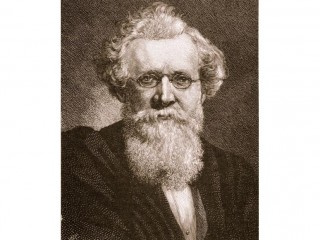
August Wilhelm Von Hofmann biography
Date of birth : 1818-04-08
Date of death : 1892-05-02
Birthplace : Giessen, Germany
Nationality : German
Category : Science and Technology
Last modified : 2010-12-28
Credited as : Chemist, Hofmann rearrangement,
The German chemist August Wilhelm von Hofmann was one of the most influential organic chemists and teachers of the century.
August Wilhelm von Hofmann was born on April 8, 1818, in the small university town of Giessen. In 1836 he entered the University of Giessen, where he studied law, philosophy, and mathematics. However, in 1843 he turned to the study of chemistry. He received his doctorate summa cum laude with a thesis entitled Chemical Investigation of the Organic Bases in Coal Tar, a field in which he was destined to achieve worldwide fame.
In 1845, while holding a professorship at the University of Bonn, Hofmann derived analine from benzene and thus laid one of the foundations of the synthetic dye industry. He also worked out the problem of substituting atoms of chlorine for the hydrogen atoms of the aromatic compounds. This work won the coveted Gold Medal of the Parisian Societe de Pharmacie and made Hofmann famous. He received and accepted an invitation from Queen Victoria in 1845 to transfer his scientific activities to London.
Working in England as researcher and teacher for 20 years, Hofmann trained a generation of brilliant chemists, including Frederick Abel, Warren de La Rue, E.C. Nicholson, Charles Mansfield, William H. Perkins, and Sir William Crookes, and a host of future leaders of the German chemical industry such as Peter Griess, George Merck, C.A. Martius, and Jacob Vilhard. In 1865 Hofmann became professor of chemistry at the University of Berlin.
Honored by the leading scientific societies of Europe, Hofmann worked in a spacious new laboratory built by a grateful government. During this period his researches were directly related to the meteoric rise of the German dye and pharmaceutical industries, which with coal and iron were the foundations of the industrial supremacy of Wilhelmine Germany. Critical to this success was what became known as the Hofmann degradation process, the successive reduction of the length of a carbon chain through treating the amides of fatty acids with bromine and alkali. Indigo was produced industrially by precisely these steps. Another of Hofmann's industrially significant accomplishments was the production of formaldehyde by passing vapors of methyl alcohol over hot platinum.
Though most of Hofmann's 360 major papers grew out of his work with the derivatives of coal tar and the synthesis of related organic compounds, he also contributed to the chemistry of cadmium, antimony, phosphorus, and titanium. He discovered the quaternary ammonium salts and was thus led to classify all amines as formal derivatives of ammonia—an idea which was the foundation of the later "theory of types" of Charles F. Gerhardt.
Hofmann was married four times and was the father of 11 children. In 1868 he helped found the German Chemical Society and served as its president 14 times. Never spoiled by fame or fortune, he continued his teaching and writing until the very end, on May 2, 1892, in Berlin.
Eduard Farber, ed., Great Chemists (1961), contains a section on Hofmann. See also Archibold Clow, The Chemical Revolution: A Contribution to Social Technology (1952); Eduard Farber, The Evolution of Chemistry: A History of Its Ideas, Methods, and Materials (1952; 2d ed. 1969); and James R. Partington, A History of Chemistry, vol. 4 (1964).
















